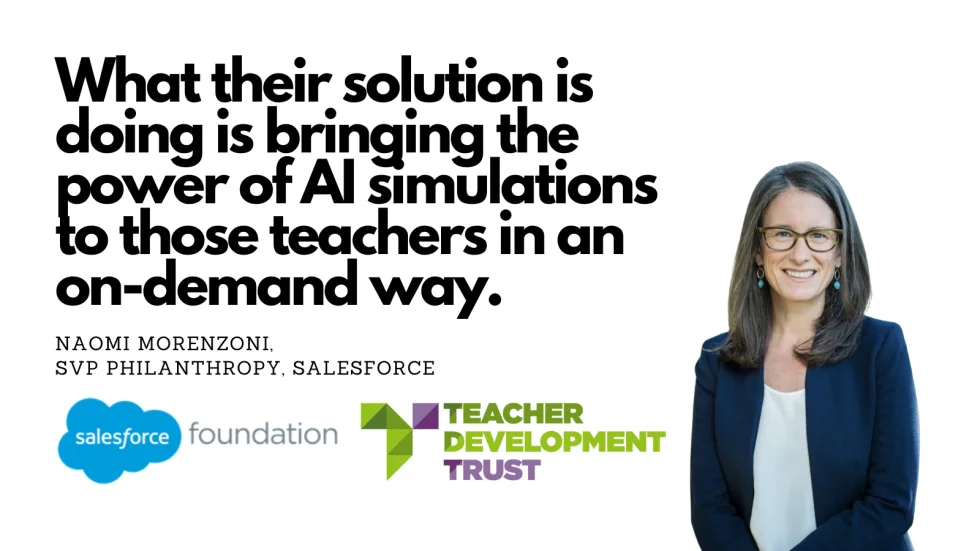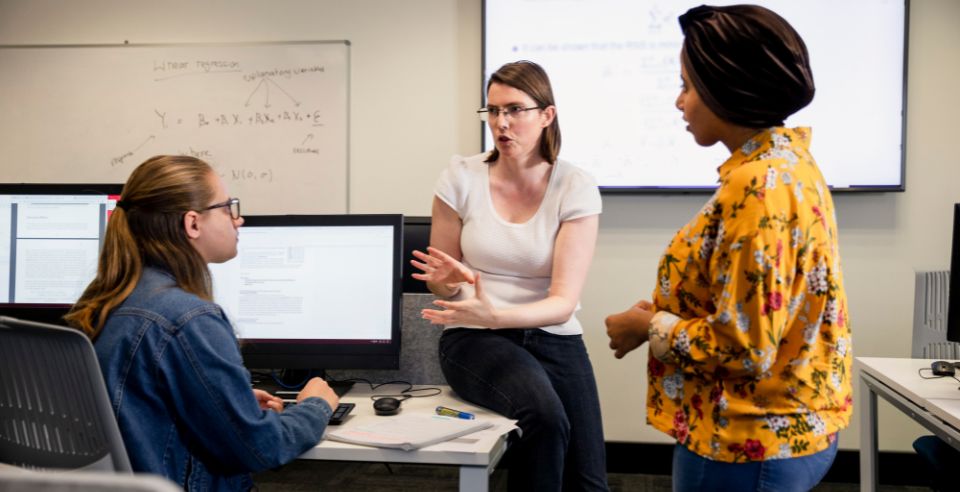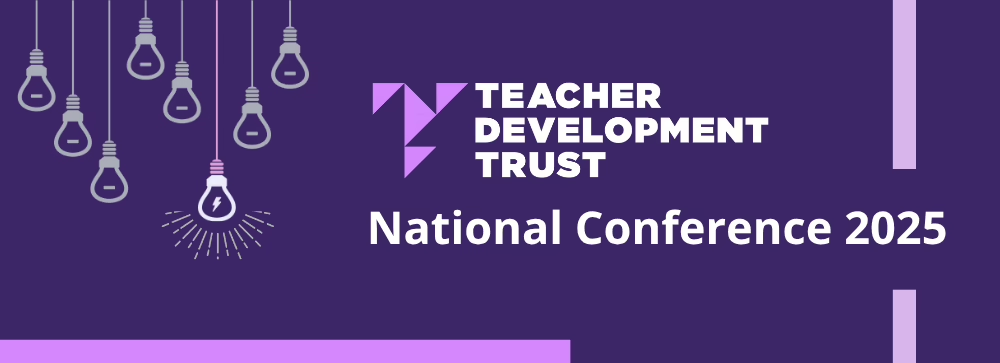High-quality professional development in early years to support children
In the first part of this blog reflecting on the importance of the first five years, Hannah Tyreman, Design and Delivery Lead, Teacher Development Trust, shares how experiences in the first five years of a child’s life can significantly determine their future.
In the first five years of their lives, children are learning behaviourally, cognitively, physically, and socially at a faster rate than at any other time in their lives (OECD, 2020).
‘Early childhood represents one of the best investments we can make for the long-term health, wellbeing and happiness of our society. Our future outcomes, whether they be academic, economic or health-related (including mental health), are profoundly shaped by our first five years’ (Centre for Early Childhood, 2021, p.5).
As they interact with their environments and connect with the people in them, children develop a wide variety of knowledge and skills, including their understanding of mathematical concepts, vocabulary acquisition, fine and gross motor skills, communication, ability to self-regulate, and sense of self, including the differences and similarities between themselves and others (Agarwal, 2020; Asmussen, Law and Charlton et al., 2018).
A child’s early development in these areas and all others is dependent on a variety of factors including the nature of their home environment, the circumstances in which they grow up, the warmth and security of their relationships, and the quality of their interactions with adults (Evangelou, Sylva and Kyriacou et al., 2009).
High-quality education in early years settings
Whether a child attends an early years setting, from what age, and the quality of education they receive there also has a significant effect on their development, critically affecting their growth (Sylva, Melhuish and Sammons et al., 2004; Sylva et al., 2012).
In good settings, children can receive additional nurturing and educational support alongside the family environment, and where they receive high-quality education from well-qualified staff, there can be a significant impact on their cognitive, personal, social and emotional development.
This development in their first five years can subsequently affect children’s short-term development and readiness for school, as well as their future achievements in primary and secondary school (Archer and Oppenheim, 2021; Melhuish and Gardiner, 2018; Sylva et al., 2004). Their early development may also influence their lives beyond education, impacting their later wellbeing, mental and physical health, resilience, empathy, self-esteem, trust, and socioeconomic status (Evangelou et al., 2009; OECD, 2020).
‘A high-quality early years education is vitally important. Children attend early years provision at a crucial developmental point in their lives. The education and care that they receive affects not only future educational attainment but also their future health and happiness’ (Ofsted, 2022).
The quality of this early education encompassing trusting relationships, purposeful interactions, high-quality pedagogy, and consistent learning routines, may be particularly significant for children encountering disadvantage, those for whom special educational needs are becoming apparent, and in addressing gaps in learning resulting from the pandemic (EEF, 2022; Ofsted, 2022a).

Effective early years professional development
Given that a child’s experiences in their first five years have such an enduring impact on later outcomes, it’s crucial to ensure that practitioners in early years settings have access to effective professional development that leads to sustained improvements to practice (Taggart, Sylva and Melhuish et al., 2015).
One way in which high-quality education can be ensured in early years settings is through effective professional development where practitioners and teachers develop the knowledge and skills to support children’s development.
‘Enhancing children’s development is skilful work, and practitioners need training and professional support to do it well’ (Evangelou et al., 2009, p.5).
The nature and quality of this professional development is key. Whilst there is a statutory obligation for early years colleagues to engage in training and professional development opportunities (DfE, 2023), the nature of professional development that will influence the quality of education for children is that which is ‘structured and facilitated’ and is ‘intended to enhance practice’ (EEF, 2023, p.6) by producing a ‘lasting change in practitioners’ capabilities or understanding so that their teaching changes’ (DfE, 2021, p.20).
Such lasting change is unlikely to result from one-off professional development sessions without any meaningful follow-up (Bonetti and Brown, 2018; Rogers, Brown and Poblete, 2017). Supporting colleagues to develop new habits and change behaviours takes time and requires regular feedback.
In their guide to effective professional development in the early years, the Education Endowment Foundation (EEF) offer a series of mechanisms that should be present in professional development for it to be effective and to have the intended impact on children’s learning. These mechanisms are illustrated in the graphic below.

Figure 1. The mechanisms of effective professional development. Adapted from EEF, 2023, p.6
A systematic review of the evidence on professional development within early years settings mirrors these design and delivery recommendations from the EEF, suggesting that effective professional development is ‘based on the best available research evidence, includes curricular content as well as pedagogical and procedural knowledge, is embedded in real contexts, and provides opportunities for reflection, feedback through coaching and peer group discussion’ (Rogers et al., 2017, p.14).
Given that children’s development in the first five years is highly dependent on the quality of education they receive in an early years setting, and this, in turn, is dependent on the quality of professional development staff receive, early years leaders may seek to prioritise evidence-informed in delivering high-quality professional development for their staff.
If you’re interested in improving how CPD is done in your Early Years setting, take a look at the resources available in our Free Hub for CPD Leadership, or browse our programmes page.
In part 2 of this blog, Mandy Cuttler, Head of Pedagogy, Learning and Development, London Early Years Foundation (LEYF), looks at the mechanisms early years leaders can use to feel equipped to select the professional development pathway that will have the maximum impact on practitioners and ultimately, the children.
References
- Agarwal P (2020) Wish We Knew What to Say: Talking with Children about Race. London: Dialogue Books.
- Archer, N. and Oppenheim, C. (2021) The role of early childhood education and care in shaping life chances: The changing face of early childhood in the UK. Nuffield Foundation. Available at: https://www.nuffieldfoundation.org/wp-content/uploads/2021/10/Role-early-childhood-education-care-life-chances-Nuffield-Foundation.pdf (Accessed: 6 November 2023).
- Bonetti, S. and Brown, K. (2018) Structural elements of quality early years provision: A review of the evidence. Education Policy Institute. Available at: https://epi.org.uk/wp-content/uploads/2018/08/Early-years-structural-quality-review_EPI.pdf (Accessed: 6 November 2023).
- Centre for Early Childhood (2021) Big Change Starts Small. Available at: https://centreforearlychildhood.org/report/ (Accessed: 6 November 2023).
- Department for Education (2021) National Professional Qualification (NPQ): Early Years Leadership Framework. Available at: https://assets.publishing.service.gov.uk/government/uploads/system/uploads/attachment_data/file/1057342/National_Professional_Qualification_for_Early_Years_Leadership.pdf (Accessed: 6 November 2023).
- Department for Education (2023). 2022 Childcare and Early Years Provider Survey (SCEYP). Available at: https://explore-education-statistics.service.gov.uk/find-statistics/childcare-and-early-years-provider-survey/2022 (Accessed: 15 December 2023).
- Education Endowment Foundation (2022) COVID-19 disruptions: Attainment gaps and primary school responses. Available at: https://educationendowmentfoundation.org.uk/projects-and-evaluation/projects/covid-19-disruptions-in-primary-schools-attainment-gaps-and-school-responses (Accessed: 6 November 2023).
- Education Endowment Foundation (2023) Guide to Effective Professional Development in the Early Years. Available at: https://educationendowmentfoundation.org.uk/support-for-schools/evidence-for-the-early-years/early-years-evidence-store/guide-to-effective-professional-development-in-the-early-years (Accessed: 6 November 2023).
- Evangelou, M., Sylva, K., Kyriacou, M., Wild, M. and Glenny, G. (2009) Early Years Learning and Development: Literature Review. Available at: http://www.complexneeds.org.uk/modules/Module-1.1-Understanding-the-child-development-and-difficulties/All/downloads/m01p060b/early_years_learning_and_development_literature_review.pdf (Accessed: 6 November 2023).
- OECD (2020) Early Learning and Child Well-being: A Study of Five-year-Olds in England, Estonia, and the United States. Available at: https://www.oecd-ilibrary.org/education/early-learning-and-child-well-being_3990407f-en (Accessed: 6 November 2023).
- Ofsted (2022) Best start in life: a research review for early years. Available at: https://www.gov.uk/government/publications/best-start-in-life-a-research-review-for-early-years (Accessed: 6 November 2023).
- Rogers, S., Brown, C. and Poblete, X. (2017) A Systematic Review of the Evidence-Base for Professional Learning in Early Years Education (The Pleye Review). UCL Institute of Education. Available at: https://discovery.ucl.ac.uk/id/eprint/10053553/1/Rogers_PLEYE_A%20SYSTEMATIC%20REVIEW%20OF%20THE%20EVIDENCE_Nuffield.pdf (Accessed: 6 November 2023).
- Sylva, K., Melhuish, E., Sammons, P., Siraj-Blatchford, I. and Taggart, B. (2004) The Effective Provision of Pre-School Education (EPPE) Project: Findings from Pre-school to end of Key Stage1. Available at: https://dera.ioe.ac.uk/18189/2/SSU-SF-2004-01.pdf (Accessed: 6 November 2023).
- Sylva, K., Melhuish, E., Sammons, P., Siraj-Blatchford, I., Taggart, B., Toth, K., Smees, R., Draghici, D., Mayo, A. and Welcomme, W. (2012) Effective Pre-school, Primary and Secondary Education 3-14 Project (EPPSE 3-14) Final Report from the Key Stage 3 Phase: Influences on Students’ Development From age 11 -14. Available at: https://assets.publishing.service.gov.uk/government/uploads/system/uploads/attachment_data/file/184087/DFE-RR202.pdf (Accessed: 6 November 2023).
- Taggart, B., Sylva, K., Melhuish, E., Sammons, P. and Siraj, I. (2015) Effective pre-school, primary and secondary education project (EPPSE 3 – 16+). Available at: https://assets.publishing.service.gov.uk/government/uploads/system/uploads/attachment_data/file/455670/RB455_Effective_pre-school_primary_and_secondary_education_project.pdf.pdf (Accessed: 6 November 2023).




